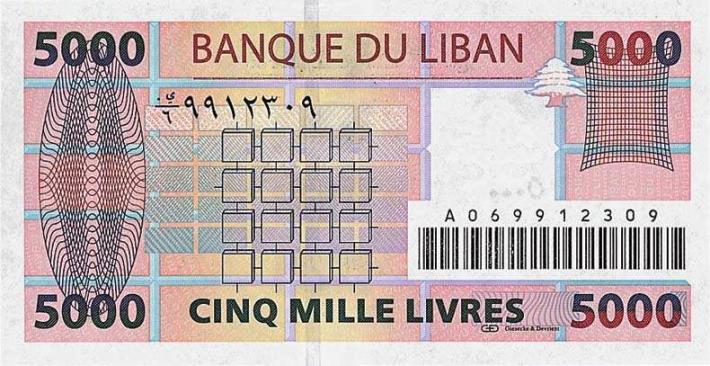|


The Lebanese lira (lira in Lebanese, or livre in French) (ISO 4217: "Lebanese lira", LBP) is the currency unit of Lebanon. It is divided into 100 piastres French but inflation has eliminated the subdivisions.
The plural form of lira, as used on the currency, is either lirat or the same, whilst there are four forms for qirsh: the dual qirshan, the plural qirush used with numbers 3-10, the accusative singular qirsha used with 11-99, or the genitive singular qirshi used with multiples of 100. In both cases, the number determines which plural form is used. Note that before the Second World War, the Arabic spelling of the subdivision was girsh. All of Lebanon's coins and banknotes are bilingual in Arabic and French.
History
BeforeWorld War 1, the Ottoman lira was used. After the fall of the Ottoman Empire, the currency became the Egyptian pound in 1918. Upon gaining control of Syria and Lebanon, the French replaced the Egyptian pound with a new currency for Syria and Lebanon, the Syrian pound, which was linked to the French franc at a value of 1 pound = 20 francs. Lebanon issued its own coins from 1924 and banknotes from 1925. In 1939, the Lebanese currency was officially separated from that of Syria, though it was still linked to the French franc and remained interchangeable with Syrian money. In 1941, following France's defeat by Nazi Germany, the currency was linked instead to the British pound sterling at a rate of 8.83 Lebanese pounds = 1 pound sterling. A link to the French franc was restored after the war but was abandoned in 1949.
Before the war of 1975-1990, 1 U.S. dollar was worth 3 pounds. According to the central bank's data, 1 U.S. dollar has been equal to 1507.5 pounds for the entire year of 2006.
Coins
Lebanon's first coins were issued in 1924 in denominations of 2 and 5 girush (note the different spelling to post WWII coins) with the French denominations given in "piastres syriennes" (Syrian piastres). Later issues did not include the word "syriennes" and were in denominations of ½, 1, 2, 2½, 5, 10, 25 and 50 girsha. During World War II, rather crude ½, 1 and 2½ girsh coins were issued.
Coins were issued in the period 1952 to 1986 in denominations of 1, 2½, 5, 10, 25 and 50 qirsh and 1 lira. No coins were issued between 1986 and 1996, when the current series of coins was introduced. Coins in current use are:
- 50 pounds
- 100 pounds
- 250 pounds
- 500 pounds
Banknotes
Lebanon's first banknotes were issued by the Bank of Syria and Greater Lebanon (Banque du Syrie et Grand-Liban) in 1925. Denominations ran from 25 girsha through to 100 pounds. In 1939, the bank's name was changed to the Bank of Syria and Lebanon. The first 250 pound notes appeared that year. Between 1942 and 1950, the government issued "small change" paper money in denominations of 5, 10, 25 and 50 girsh or qirsh (the change in spelling occurred during these years). After 1945, the Bank of Syria and Lebanon continued to issue paper money for Lebanon but the notes were denominated specifically in "Lebanese pounds" (livres libanaise) to distinguish them from Syrian notes. Notes for 1, 5, 10, 25, 50 and 100 pounds were issued. In 1964, the Bank of Lebanon took over banknote production. Their notes are denominated in pounds. A 250 pound note reappeared in 1978, followed by higher denominations in the 1980s and 1990s as inflation drastically reduced the currency's value. All current notes feature an Arabic side with the value in Arabic script numerals of large size. The other side is in French with the serial number in both Arabic and Latin script and in bar code below the latter one.
The text on this page has been made available under the Creative Commons Attribution-ShareAlike License and Creative Commons Licenses
|
